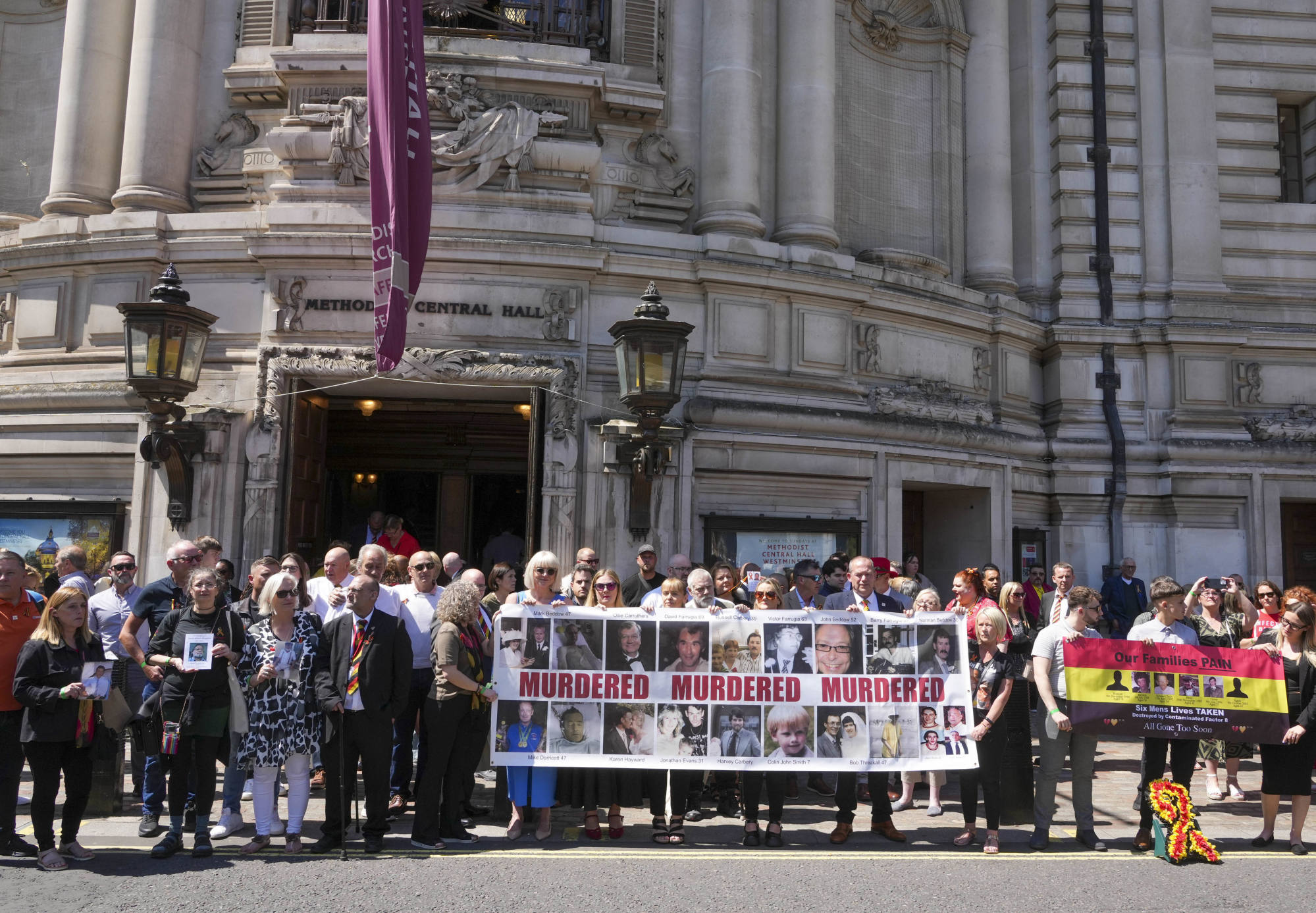An inquiry into Britain’s decades-long contaminated blood scandal slammed the UK state and found evidence of a “chilling” cover-up, a watershed moment for the country after what’s widely seen as the worst treatment disaster in the history of the National Health Service.
Brian Langstaff, chairman of the Infected Blood Inquiry, described the scandal as a “calamity” that should have been avoided and involved “systemic, collective and individual failures to deal ethically, appropriately, and quickly, with the risk of infections being transmitted in blood”.
“The scale of what happened is horrifying,” Langstaff said in the report published on Monday. The cover-up was “chilling in its implications”, he said. “To save face and to save expense, there has been a hiding of much of the truth.”
More than 30,000 people were infected with HIV and hepatitis C in the UK in the 1970s and 1980s after receiving treatments with blood products contaminated with deadly viruses.
Victims and their families have spent decades fighting for justice and compensation, yet a public inquiry was only announced in 2017. Langstaff said there was enough information to warrant one as early as 1986.
Prime Minister Rishi Sunak is expected to issue an apology on behalf of the state when he addresses Parliament later on Monday, and the government is due to announce compensation in excess of £10 billion (US12.7 billion) for the victims and their relatives as soon as Tuesday.
Chancellor of the Exchequer Jeremy Hunt, a former health secretary, has called it “the worst scandal” of his lifetime.
The implications of the findings are profound, painting a picture of professional negligence but also of administrators and governments of various political persuasion refusing to engage with mounting evidence that a major scandal had occurred.
The victims were infected at a time when there was still considerable stigma around HIV especially, and before treatment was widely available.

“There are a handful of examples that raise serious issues of intentional interference in medical records,” Langstaff wrote. “There may have been a closing of ranks in certain situations, resulting in somebody thinking it would be wise to remove items from medical records.”
There are also clear parallels with other scandals that have engulfed the British establishment, including but not limited to the delay before administrations commit to an inquiry and compensation.
That list includes the 96 football fans unlawfully killed at Hillsborough in 1989, and the police cover-ups and other injustices that followed.
The Post Office scandal, in which hundreds of staff were falsely accused of theft due to faulty software, is another slow-burn disaster that has finally reached the compensation stage on Sunak’s watch.
That the infected blood scandal – like the others – dragged out over so many years means the political fallout is not clear-cut. Langstaff’s inquiry was announced in 2017 by then Prime Minister Theresa May, and Sunak’s administration has faced criticism for not moving toward full compensation until the full report was published.
The inquiry had already recommended interim payments of at least £100,000 to the infected and all bereaved partners, and the government has said it’s paid out £400 million so far.
Langstaff said the government hadn’t moved quickly enough to provide redress.
“It may be that justice and redress are just around the corner – for those who are still alive,” he said. “But at the time of writing this report, I have no way of knowing if this is the case. Nor, more importantly, do those infected and affected. That is a serious failing which replicates the wrongs of the past.”
Yet, the recriminations stretch back well before the current Conservative administration, which has been in power since 2010. Paul Johnson, director at the Institute for Fiscal Studies, told Times Radio on Monday that when he was working for the Treasury in the 2000s, the then Labour governments of Tony Blair and Gordon Brown also knew about the scandal and “deliberately decided not to do anything about it”.
The infected blood treatments took place when both the Tories and Labour were in power in the 1970s and 1980s.
“An awareness that compensation might be recommended was a central factor in the unwillingness of successive governments to establish a public inquiry earlier than 2017,” Langstaff wrote.

Hunt told the infected blood inquiry that the state had closed “ranks around a lie” to protect itself. The slowness to act over many years had also been motivated by concerns that compensation would have to be paid directly out of the NHS’s budget, likely compounding pressure on stretched front-line services.
Beyond the focus on individual parties and governments, though, the impact is likely to be more broadly felt in terms of lost trust in British institutions and politics itself.
As in the Hillsborough case, the infected blood probe risks underscoring the sense that the British state is not working for its citizens.
The catastrophic fire at London’s Grenfell Tower in 2017 is the subject of another public inquiry, which is looking at the impact played by UK construction rules.
Two main groups of NHS patients were affected by the scandal: haemophiliacs and recipients of blood transfusions.
In the 1970s the British government was struggling to meet demand for blood-clotting treatments so imported supplies from the US, but what they bought often came from blood from high-risk donors such as prison inmates and drug users.
Whole batches were contaminated, meaning patients went on to develop conditions such as hepatitis C and HIV. It’s estimated that about 3,000 people have died because of the infected blood treatments.
“Now is the time for national recognition of this disaster and for proper compensation to all who have been wronged,” Langstaff said.


